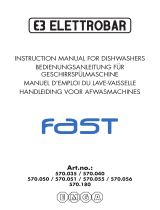
DICHIARAZIONE DI CONFORMITA' CE
DECLARATION OF CONFORMITY CE
DECLARATION DE CONFORMITE CE
KONFORMITÄTSERKLÄRUNG CE
DECLARACION DE CONFORMIDAD CE
DECLARAÇAO DE CONFORMIDADE CE
È stata progettata e costruita in conformità alle norme armonizzate:
Is in compliance with the International regulations:
Est conforme aux normes internationales:
Mit den internationales Vorschriften konform ist:
Es conforme a las normas internacionales:
Esta de acordo com as normas internacionales:
secondo quanto prescritto dalle seguenti direttive e successivi emendamenti:
according to the following directives and standards and further amendaments:
selon les prescription et directives suivantes et les amendements successifs:
die folgenden Richtlinien und späteren Normen gemäß ist:
la prescripcion de la siguientes directivas y en los normas sequen:
de acordo com as normas internacionales:
- declina ogni responsabilità per sinistri a persone, a cose o ad animali derivanti da manomissione della macchina da parte di terzi, ovvero da carenze di
manutenione, di riparazione o di installazione della stessa da parte di personale non qualificato.
- declines all responsibility for damages ro people, properties and animals reslting from bad servicing of the machine by third parties as from inadequate
mainenance or repairs or installation by unskilled workers.
- décline toute responsabilité pour tout sinistre à personnes, choses ou animaux résultant de l'endommagement de la mchine per des tiers, c'est-à-dire dû à une
maintenance, des réparations ou une installation inadéquates effectuées par du personnel non-qualifié.
- die Firma Dihr lehnt jede Verantwortung für an Personen, Sachen und Tiere verursachten Schäden ab, welche von Manipulation beziehungsweise Änderung seitens
Dritten, unsachgemässenem Gebrauch der Maschinen, mangelhafte Wartung und Reparaturen ober Inbretriebsnahme seitens unsachliches Personals abhängig sind.
- declina toda responsabilidad por daños a personas, cosas o animales producidos del mal servicio de la maquina por terceras partes asi como por reparaciones
o mantenimiento indadecuados o de instalaciones por parte del personal no cualificado.
- declina toda e qualquer responsabilidade por danos causados a pessoas, bens e animais, resultantes do mau manuseamento da máquina por parte de
terceiros assim como mautenção incorrecta ou reparações indadequadas ou instalação por pessoal não qualificado.
- e in applicazione a quanto previsto dalle direttive citate, sono state dotate di marchiatura CE e sono stati predisposti i fascicoli tecnici presso la nostra sede.
- and pursuant of the above mentioned directives, the CE marks have been applied. Furthermore, adeguate technical materials have been prepared and are
available from our offices.
- en application des directives citées, il portent la marque CE et les dossiers technique sont déposés dans notre siége.
- Und daß er in Ubereinstimmung mit den Vorschriften obenganannten Richtlinien mit dem CE-Zeichen vorgesehen sind und daß für Ihn angernessenes
technisches Haften herstellten wurde, die bei uns in der Firma zur Verfügung stehen.
- y, conforme con lo previsto en las citadas directivas, han recibido la marca CE. Existe asimismo los especifico prospectors técnicos relativo disponible en
nuestra sede.
- a marca CE foi aplicada no seguimento das directivas acima mencionadas. Os equipamentos estao tecnicamente preparados e adequado e encotram-se
disponiveis mas nossas instalçoes.
ANNO DI COSTRUZIONE
MANUFACTORING YEAR
ANNEE DE CONTRUCTION
JAHR DES BAU
AÑO DE CONSTRUCCIÓN
ANO DE FABRICO
2007
EN 60335-1
EN 60335-2-58
EN 55014-1
EN 55014-2
CASTELFRANCO VENETO, data
2006/95/CE
93/68
92/31
89/336
Il sottoscritto, legale rappresentante della azienda sopra indicata, dichiara che l'apparecchiatura:
The undersigned, officer of the above-written company, hereby declares that the machine:
Le soussigné, représentant légal désigné, déclare que l'appareil:
Der Unterzeichenete als rechtilicher Vertreter der oben genannten Firma, erklärt, daß die Einrichtung:
Quien subscribe, designado representante legal de la empresa antes mencionada, declara que el aparato:
O abaixo assinado, legal representante da emprese acima mencionada, declara que a maquina:
A. I. Spinetti
Managing Director
n
n
n
n
n
n
n
n
n
n
n
n
KROMO S.R.L. - VIA MESTRE, 3 - 31033 CASTELFRANCO VENETO (TV) ITALY - TEL. ++39-423-734580 - FAX ++39-423-734581
RoHS 2002/95/CE
WEEE 2002/96/CE 2003/108/CE
Undercounter machines : AQUA - DUPLA - LUX
Hood type machine : HOOD
Warewashers type machine : KP - GR





















